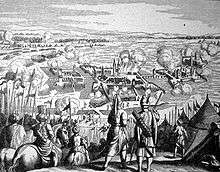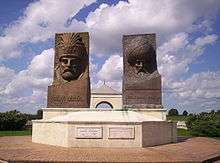Szigetvár
| Szigetvár | ||
|---|---|---|
|
Aerial Photography: Szigetvár - Castle | ||
| ||
 Szigetvár | ||
| Coordinates: 46°02′54″N 17°48′45″E / 46.048269°N 17.812569°ECoordinates: 46°02′54″N 17°48′45″E / 46.048269°N 17.812569°E | ||
| Country |
| |
| County | Baranya | |
| Area | ||
| • Total | 39.51 km2 (15.25 sq mi) | |
| Population (2009) | ||
| • Total | 10,900 | |
| • Density | 288.33/km2 (746.8/sq mi) | |
| Time zone | CET (UTC+1) | |
| • Summer (DST) | CEST (UTC+2) | |
| Postal code | 7900 | |
| Area code(s) | 73 | |
Szigetvár (Hungarian pronunciation: [ˈsiɡɛtvaːr]; Croatian: Siget; Turkish: Zigetvar; German: Inselburg) is a town in Baranya County in southern Hungary.
History

The town's fortress was the setting of the Battle of Szigetvár in 1566. It was a sanjak centre at first in Budin Province (1566–1601), later in Kanije Province (1601–1689).
There was already a fortress in the marshland back in Celtic and Roman times. The Castle of today was built on an artificial island - created by filling up the swampy area and driving the stream into a canal - in the 15th century. If you walk along the top of its external walls, 4 m thick at some places, you can get great views of the town. The bridge over the inner moat stands at the place where Nikola Šubić Zrinski and his soldiers broke out of the inner castle. The equestrian statue of Zrinski (*Zrin in modern Croatia, around 1508. - †Szigetvár, 7. September 1566.) commemorates the self-sacrifice of the heroic captain of the castle. It is said that the Turks built the mosque of sultan Suleiman I and the minaret beside it - only part of the latter can be seen today - in the honour of their sultan who died after the castle was conquered.[1] The former Andrássy Palace, hosting the exhibitions of 'Zrínyi Miklós Museum' on the history of the castle, is also next to them.
Some other monuments in the town also date back to Turkish times. Two years after the siege, the mosque of Ali Pasha was built, later - in 1788 - to be transformed into a Christian church: the Roman Catholic parish church. The two minarets, as well as the windows and niches with ogee arches indicate its original function. The Turkish House of red raw brick walls and interlaced steel window grills in Bástya Street was originally destined to be a caravanserai. The two holy-water basins of the Franciscan Church were made of Turkish washbasins. The carved main altar of the Baroque Church is another sight to see.
In 1966, on the 400th anniversary of the siege, Szigetvár regained its old rank of a chartered ancient city. Development began to gather speed. Today it has a population of 12,000. In October 2011, the city received the title Civitas Invicta from the Hungarian Parliament.[2]
In 1994, the Hungarian-Turkish Friendship Park (Hungarian: Magyar-Török Barátság Park) was established as a public park, dedicated in memorial to the Battle of Szigetvár.[3]
Along with the cannery and the shoe factory, more and more small-size private businesses offer new jobs to local people. The town has a regional hospital with 450 beds, several primaries and secondary schools, a student hostel for 100 persons as well as a music school.
International relations
Twin towns — Sister cities
Szigetvár is twinned with:
Gallery
-

Turkish-Hungarian Friendship Park in Szigetvar
-

Turkish-Hungarian Friendship Park in Szigetvar
See also
References
- ↑ Misiroglu, Kadir (2009). Sokullu Mehmed Pasa. Istanbul: Sebil Yayinevi. p. 101. ISBN 9789755800455.
- ↑
- ↑ Karikó, Sándor & Tibor Szabó (December 6–8, 2009). Ferrari, Angelo, ed. "A Hungarian-Turkish Cultural Heritage: Scandal and Reconciliation". PROCEEDINGS 4th International Congress on “Science and Technology for the Safeguard of Cultural Heritage in the Mediterranean Basin” (Cairo, Egypt) 1: 18. Retrieved 2013-08-26.
- ↑ "City Twins". Imatra. Retrieved 4 May 2014.
External links
- Official website (Hungarian)
- Szigetvár at funiq.hu (English)
| Wikimedia Commons has media related to Szigetvár. |


